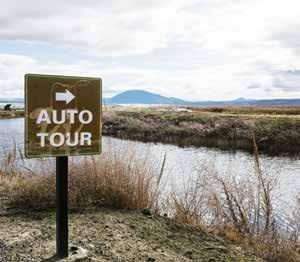
4 minute read
drive through education
EASTERN SISKIYOU AUDIO TOURS
EASTERN SISKIYOU County is a rugged volcanic landscape full of natural wonders that include the Tule Lake National Wildlife Refuge, the Lower Klamath National Wildlife Refuge and the Lava Beds National Monument. And now, thanks to a couple of free audio tours that combine sightseeing, history, storytelling and a novel driving tour technology, you can visit these iconic spots in your own car at your own pace – with all the benefits of a guided tour and none of the drawbacks.
“We wanted to bring more people into our area to experience the valuable national and local history. We also wanted to involve multiple rural communities in one featured attraction so the audio tour was a perfect fit,” explains Linda Woodley of Rural Klamath Connects, a regional economic development group that created the first audio tour to bolster tourism in the area.
The initial tour, entitled “The Modoc War: A Homeland Lost,” is an epic story about the origins of the Modoc War and takes visitors from the starting point just over the Oregon border in Klamath Falls, through 60 miles of important and scenic landmarks to the Lava Beds National Monument in Tulelake. Fought over a six-month period, the Modoc War was a series of skirmishes from 1872-1873 that saw 55 to 60 Modoc warriors from their Stronghold keep as many as 1,000 Army soldiers at bay – without ever losing a battle. Today, the war is recognized as one of the costliest in United States history in terms of lives lost and dollars spent per enemy combatant, and its effect on the Modoc People and eastern Siskiyou has been profound.
But unlike a standard museum tour that moves from site to site with “dead space” in between, much of the audio tour unfolds during the driving sections of the tour and incorporates the geography into the tour. Touted as an “immersive, GPS-enabled tour,” it works something like a “location-aware” podcast with music and sound effects. The route is also carefully constructed to build the narrative with the environment, forming a truly three-dimensional storytelling experience. “I love the fact that the speed of the tour is the decision of the people in the car – where if they want to spend more time at a site, they can. If they want to talk about what4 continued on page 26
they’ve experienced there before moving on, they can. There are chances to share our emotions and ask questions of each other,” explains Cheewa James, acclaimed author of the book “Modoc: The Tribe that Wouldn’t Die” and narrator of the tour.
But James’ deeply personal connection to the story makes the tour most compelling. Not only does she know the land intimately having once worked at the Lava Beds as an site interpreter, she is the great-granddaughter of Shkeitko (known by his English name as “Shacknasty Jim”), one of the Modoc warriors who fought in the Stronghold. Her first-hand familial knowledge is interwoven throughout the tour, from the birth of her grandfather inside the Stronghold to the inclusion of an ancient Modoc song that’s been passed down through generations.
“The Change Song is an ancient Modoc song with an invitation to people to accept that change is a continuing part of life. It happens, things move on,” James says. “The song invites all people, not just Modocs, to be a part of the song’s meaning – that we move together, often helping one another, through change.” For visitors, this personal lens creates a one-of-a-kind experience that brings history to life. “History is only as dull as the way it is approached. In this case, the stories, the music, the excitement create a picture of a different kind of life over 100 years ago,” James notes.
The launch of The Modoc War audio tour has since inspired a companion tour. “We were so impressed by the Modoc Audio Tour we felt that it would be a wonderful way to share the Refuge’s story with visitors, as well,” explains John Fitzroy, the Visitor Services Manager for U.S. Fish and Wildlife Service that manages both the Tule Lake and Lower Klamath National Wildlife Refuges. Launching this summer, the second audio tour is a roughly 20-mile tour that

Photos courtesy of Discover Siskiyou

Photos courtesy of Discover Siskiyou

Photos courtesy of Discover Siskiyou

Photos courtesy of Discover Siskiyou

Photos courtesy of Discover Siskiyou
takes visitors through the heart of the Tule Lake National Wildlife Refuge and ends at the adjacent Lava Beds National Monument.
“Since the end of the last Ice Age, Tule Lake has been an oasis for wildlife, particularly migratory birds which depend on the ebb and flow of these vast and unique arid wetlands. We’re hopeful that the story of these lands and how people have shaped them over time will instill a sense of wonder and excitement for the Refuge and its mission to preserve wetlands for future generations.”
Both tours are free. To access them, visitors must first download the VoiceMap mobile app to their mobile device (free and compatible with both Android and iOS), then follow step-bystep instructions in the app. Additional information and links are at www.discoversiskiyou. com and www.discoverklamath.com. •
Megan Peterson is a Chico native who lives in Etna. For nearly two decades she’s written, produced and pitched content for a variety of television networks, including the Travel Channel, National Geographic and Discovery. She works at Discover Siskiyou and considers Siskiyou her muse.



